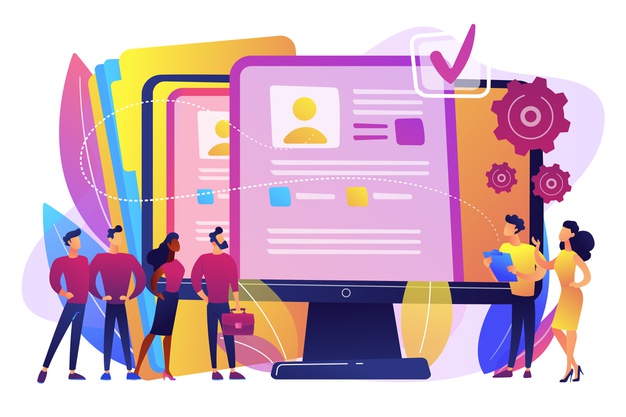Send Us a Message
Contact Information
Skizzle Technolabs India Pvt. Ltd.
Noel Focus, Kakkanad,
Kerala, India – 682021
The field of human resources management has evolved significantly over time and continues to grow rapidly each and every day. While HR professionals still concentrate on the “human” aspects of the management of an organization, they also rely more and more on technology and data which they did not even have a decade ago.

The emergence of this data — and its effect on HR processes — led to a new term and discipline: analytics of human resources. HR Analytics has brought about a paradigm shift and has equipped executives, VPs, and human resources experts focused on current human management systems with a data-driven strategy for creating sustainable business growth with HR KPI’s involvement.
Human resources can enhance their game by assessing the cost of recruiting, evaluating the turnover rate for jobs, identifying training opportunities to improve the performance of employees and resolving even more data problems, and offering practical guidance, thus minimizing the cost associated with HRs.
That said, in this blog, we will address the core foundations of HR and highlight the value of analytics, explain why you should embrace HR analytics within the company, explain how the most important advantages can be achieved in the business.
HR Analytics is a term used to define processes in the HR department that are designed to capture, monitor, and analyze the HR data to produce actionable information and maximize employee, resources, and/or business development performance in the organization. The process can also be referred to as talent analytics, people analytics, or even workforce analytics.
People analytics, also known as talent analytics, aims to consolidate data from multiple people management touchpoints to enable managers and executives to make more conscious, data-driven choices about their talent acquisition and management processes.
To make strategic and better talent decisions, organizations use these kinds of analytics, including measuring talent engagement, rating systems, recruitment statistics, etc., using emerging technology and tools such as advanced applications for HR analytics.
Most organizations have already frequently collected data, so why do they need a specialized analytical form? Should HR not just look at the details they have?
Unfortunately, raw data alone cannot provide any valuable insight. Without organization or direction, the data appears meaningless. Once organized, compared, and analyzed, this raw data provides useful insight.
They can help answer questions like:
With data-based proof, organizations may concentrate on improving and preparing the future initiatives required. It is not surprising that many firms that use HR analysis attribute performance improvements to HR-initiatives because they are able to respond without guessing to major organizational questions.
As the economy and the human resources industry shift constantly to meet the needs of the modern age, those who wish to develop a career in HR must increase their capacities and prepare themselves to wear many hats. HR experts need to be able to evaluate and gain useful information to help a company achieve its strategic objectives.
Below we discuss the three fields in which HR analytics have the best impact on an HR professional’s job.
1. Performance and Efficiency
Many companies assess success by the overall performance and productivity of human resources operations and processes. Tracking metrics can provide useful insights into the efficiency of such processes.
For example; as an HR professional, you might track the retention rate of new hires by source. Over time, you can learn that such data, like internal references, result in substantially higher retention rates than other sources (such as LinkedIn postings). With this information, you can then reorganize your workflows to give preference to internal referrals over weaker channels, understanding that during the recruitment process this is likely to improve your performance.
Other common metrics that can be used in a comparable manner include recruiting duration, hiring effectiveness, applications, and hiring by sources, applicants per opening, offer acceptance rates, and employee satisfaction rates, amongst others.
Using knowledge to understand how the processes and workflows work, you will think objectively about how to use your resources to concentrate on the areas that will have the greatest overall effect.
2. Recruitment and Hiring Processes
Filling open positions within an organization is often a costly endeavor, both in terms of time and money. For this reason, taking the time to improve a company’s recruitment and hiring processes via data analytics can lead to significant savings.
In this case, data will help HR professionals understand who is ideally suited to a particular role and the overall culture of their workplace. When workers get the right first time, HR practitioners will spend more time working on retention and less time replacing an unworked employee.
Exit interviews, staff satisfaction surveys, team evaluations, and quarterly/annual assessments all provide useful insights into the ability of candidates to succeed within the company. Data obtained during the recruiting process can also be used to create better packages and deals, decrease friction and obtain other excellent results.
3. Employee Experience
Human resources managers do more than sift through applications to fill open positions. They also monitor the employee experience and take steps to improve it, because happy employees tend to be more engaged. This engagement can result in higher productivity, greater retention, and higher levels of success overall.
HR practitioners can achieve a better understanding of the overall employee experience through measuring factors such as attendance, efficiency, and engagement. HR will help to decide where the business shines and where changes can be made. Based on these experiences, salaries, incentives, holiday policies and resources for professional training and advancement all can be optimized.
Predictive Analytics analyzes historical data in order to forecast the future. The differentiator is the way data is used.
In standard HR analytics, data is collected and analyzed to report on what is working and what needs improvement. In predictive analytics, data is also collected but is used to make future predictions about employees or HR initiatives.

This can include anything from predicting which candidates would be more successful in the organization, to who is at risk of quitting within a year.
How does it work?
Advanced statistical techniques are used to create algorithmic models capable of identifying trends and future behaviors. These future trends can describe possible risks or opportunities that organizations can leverage in long-term decision-making.
Predictive HR Examples
Let’s take a look at how predictive analytics can be used:
Turnover
With predictive analytics, an algorithm can be devised to predict the likelihood of employees quitting within a given timeframe. Being able to flag which employees are at risk enables organizations to step in with preventative measures and avoid the cost of losing productivity and the cost of re-hiring.
Organizational Performance
Historical data can pinpoint reasons for poor performance, but predictive analytics can make predictions about what initiatives are most likely to improve performance. If engagement levels are identified as being correlated with performance, then organizations can implement specific initiatives that boost employee engagement.
The benefits and challenges of predictive HR analytics
Benefits: Predictive HR analytics enables organizations to become proactive in their use of data.
Instead of fixing past problems, organizations can create a future that prevents problems and solves future challenges before they even happen. This can save on future costs, both in revenue, goals, and productivity.
Challenges: Predictive HR analytics requires a level of skill, technology, and investment that many organizations do not yet have.
Many factors also need to be taken into consideration in order to make predictions about employees or potential candidates.
Human beings can be unpredictable and have different personalities, backgrounds, and experiences. Slotting people into a black and white algorithm in order to make predictions about their job performance or future poses not just a risk, but an ethical question.
In order to tackle the challenge, in some cases, businesses can rely on employee background verification companies as well.
A great experience with employees would certainly contribute to improved business performance. As a result, executive and senior executives are looking for strategies that can understand what’s going on in-depth and provide a summary of what’s going on in the company.
With the capability for the aggregation of huge sources of data, an elegant interface that does not require advanced analytic or technical skills, SkizzleHR is there to help you become more data-driven and base your decisions on unbiased facts. Join SkizzleHR Beta and find about SkizzleHR’s treasurable insights!!

High-performing teams are the distinctive feature of an industry-leading business. This can ensure the business's success in the long run. Working in a team...
Read More
Since the pandemic hit the world, the new normal is working from home. Gen Y and Gen Z are the largest workforce units of...
Read More
You have much to consider when looking for a solution for human resources (HR) technology. What is the right fit for you? How are...
Read More
As we have seen human resources and information technology have become more intertwined during the last decade. Manufacturing, financials, sales and marketing, and supply...
Read MoreSkizzle Technolabs India Pvt. Ltd.
Noel Focus, Kakkanad,
Kerala, India – 682021